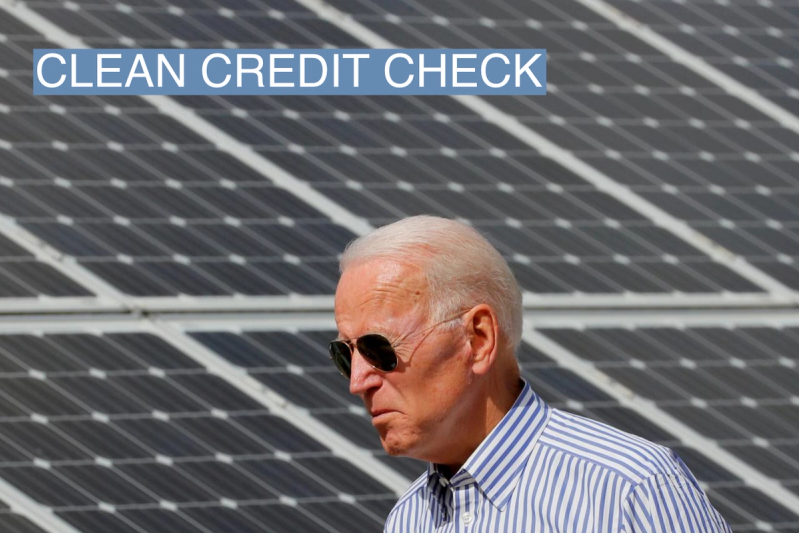The News

Tradable tax credits are becoming a hot commodity in the renewable energy industry.
A new breed of climate tech startup is emerging to take advantage of provisions in the U.S.’s Inflation Reduction Act that for the first time allow clean-energy tax credits to be bought and sold. That trading will unlock tens of billions of dollars in previously inaccessible financing for solar, wind, and battery farms, in particular projects whose scale falls between an individual household and a huge installation.
Those projects, which often went unbuilt due to a lack of financing, could dramatically speed up progress toward the Biden administration’s goal to fully decarbonize the electricity grid by 2035. The provisions also present a new method for all kinds of companies to get a break on their taxes in a way that looks good on their sustainability marketing.
Tim’s view
Over the last 20 years, tax headaches have hampered the rollout of renewable energy in the U.S. at least as much as technology glitches, supply chain bottlenecks, or competition from fossil fuels. But the IRA changes the game by allowing project developers to sell their tax credits without the hassle and expense of a frequently used type of financing known as tax equity. That reform is one of the law’s biggest, if least heralded, victories.
The market for renewables tax-equity deals is about $15-20 billion annually. That number is unlikely to grow, especially with a recession looming. If project developers can sell their tax credits in a relatively painless way to any corporate taxpayer, it will at least double the amount of financing available, said Eric Rubinstein, chief investment officer at Leyline Renewable Capital, a North Carolina-based clean energy investment firm. That would keep tax financing on pace with projected demand.
Say you’re a company that develops midsize solar farms and has interest in a project from a rural farming town. You predict the tax credits the project will qualify for once built. Then you look for a buyer: any company from Google to a grocery store chain. You sell the credits at a discount — lawyers I spoke to said the ranges being negotiated for the first IRA-enabled credit sales are 85-95 cents per dollar. You get cash to do the project, the middleman takes a fee, and the buyer gets a discounted tax break and an opportunity to tell everyone they’re supporting clean energy that might not have been built otherwise.
That’s where the startups come in. Reunion Infrastructure and Basis Climate were both launched after the IRA passed, raising an undisclosed amount of venture capital seed funding this year. Both were founded by veterans of the renewable energy finance industry, with a similar business model: To act as a marketplace connecting sellers and buyers of tax credits. Both startups are developing insurance programs in case the project doesn’t actually get built, and lawyers said more government guidance is needed to ensure tax credit buyers don’t wind up on the hook or under audit if projects don’t materialize.
The upshot is that the pool of possible financiers grows from a handful of big banks to anyone with a corporate tax bill, and a lot more clean energy gets built.
Know More
Renewable energy projects in the U.S. can tap one of two tax credits. Prior to the IRA, many project development companies were unable to use these credits directly, either because they didn’t have enough taxable income to make full use of them, or because they needed cash upfront to actually get the project built. Instead, they typically sought a tax equity deal, in which a bank or other financier puts up cash, becoming a partial owner of the project, and allowing the financier to count the credits against its own taxes.
There are two problems with these deals. One, they’re notoriously tedious and require teams of accountants and lawyers — the term “brain damage” gets used a lot to describe them. Two, there’s simply not enough tax equity financing available to cover all the projects out there. Where there is, it tends to get eaten up by the biggest projects, like an offshore wind farm that costs hundreds of millions of dollars. Smaller projects — solar on the roof of a commercial warehouse or in a field next to a university — weren’t worth it. The investor-owned utilities that operate most of the nation’s coal-fired power plants have also been held back in switching to renewables in part because their regulatory structure prevents them from entering tax equity deals. The IRA’s transferability reforms should go a long way toward solving these problems.
Room for Disagreement
The market for tax credit trading is certain to grow quickly, Rubinstein said, drawing in the traditional big accounting firms that most companies are more accustomed to dealing with. “I’m skeptical that startups will be able to unseat the incumbents,” he said. And if the Internal Revenue Service does open the door for individuals to buy tax credits, as it is considering, the startups will also face competition from filing services like TurboTax.
The View From Texas
Transferability isn’t the only tax innovation in the IRA. The new law also extends tax breaks beyond wind and solar to a range of other technologies including batteries, nuclear, geothermal, and hydrogen. The first investment in utility-scale batteries made possible by IRA tax credits was announced this week, for a 200-megawatt pair of batteries in Mission, Texas.
Notable
- The IRA’s plethora of grants, loans, and tax breaks have turned the U.S. into the world’s most attractive investment destination for renewables, the Financial Times reported, with $90 billion in new investment announced since the law passed. The U.S. is on track for $114 billion per year in clean energy investment by 2031.

